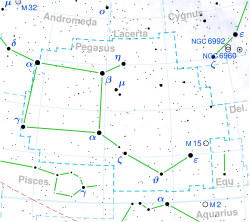HD 209458
| Observation data Epoch J2000 Equinox J2000 |
|
|---|---|
| Constellation | Pegasus |
| Right ascension | 22h 03m 10.8s |
| Declination | +18° 53′ 04″ |
| Apparent magnitude (V) | 7.65 |
| Characteristics | |
| Spectral type | G0V |
| Apparent magnitude (B) | 8.24 |
| Apparent magnitude (K) | 6.3 |
| B−V color index | +0.574 ±0.014 |
| Variable type | EP |
| Astrometry | |
| Radial velocity (Rv) | -14.8 km/s |
| Proper motion (μ) |
RA: 28.90 mas/yr Dec.: -18.37 mas/yr |
| Parallax (π) | 21.24 ± 1.00mas |
| Distance | 154 ly (47.1 pc) |
| Absolute magnitude (MV) | 4.28 ±0.10 |
| Details | |
| Mass | 1.13 -0.02+0.03 M☉ |
| Radius | 1.14 -0.05+0.06 R☉ |
| Luminosity | 1.61 L☉ |
| Temperature | 6000 ±50 K |
| Metallicity | 0.00 ±0.02 |
| Rotation | 14.4 days |
| Age | (4 ± 2) × 109 years |
| Other designations | |
| Database references | |
| SIMBAD | data |
| Exoplanet Archive | data |
| Extrasolar Planets Encyclopaedia |
data |
HD 209458 is an 8th-magnitude star in the constellation Pegasus. It is a G0V star, and is thus very similar to the Sun. Because it is located at a distance of about 150 light years, it is not visible to the unaided eye. With good binoculars or small telescope it should be easily detectable.
In 1999, two teams working independently (one team consisted of astronomers at the Geneva Observatory, the Harvard-Smithsonian Center for Astrophysics, and the Wise Observatory; the second group was the California and Carnegie Planet Search team) discovered an extrasolar planet orbiting the star by using the radial velocity planet search method. Soon after the discovery, separate teams led by David Charbonneau and Gregory W. Henry were able to detect a transit of the planet across the surface of the star making it the first known transiting extrasolar planet. The planet received the designation HD 209458 b.
Because the planet transits the star, the star is dimmed by about 2% every 3.5 days making it an extrinsic variable. The variable star designation for HD 209458 is V376 Pegasi. It is the prototype of the variable class "EP" in the General Catalogue of Variable Stars, defined as stars showing eclipses by their planets.
...
Wikipedia

